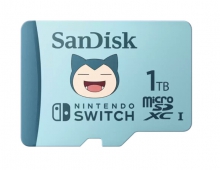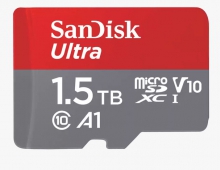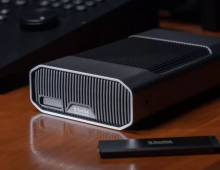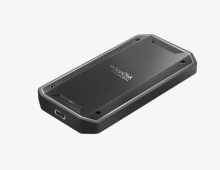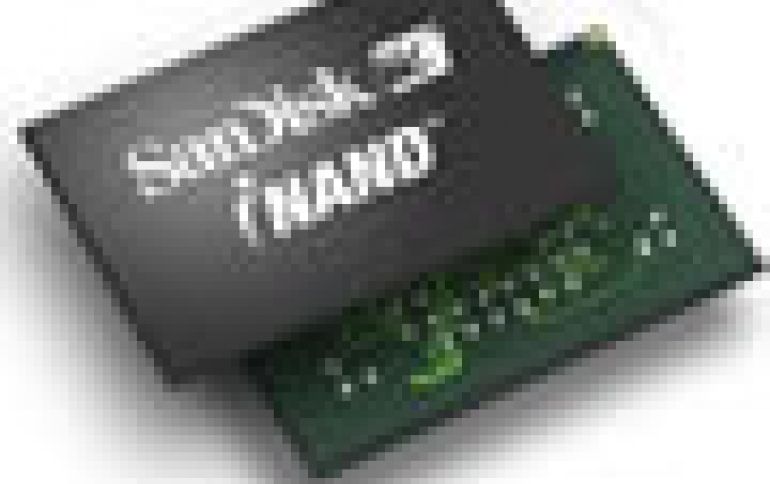
Embedded Storage Device to Replace Micro Hard Drives
SanDisk 's iNAND is a small, high-speed NAND flash storage device that the company is touting as an alternative to micro hard drives in mobile applications.
Embedded flash memory is expected to revolution products in the future, it is now the most popular storage solution for consumer electronics products such as MP3 players, GPS devices, personal media players and mobile phones.
The embedded storage device employs the company's TrustedFlash technology that will enable consumers to buy premium music, movies and games on flash memory cards for use interchangeably in mobile phones, laptop computers, PDAs and other portable devices.
iNAND combines the high-speed NAND flash memory with a serial controller in a single device. The iNAND controller saves host system CPU and RAM buffering and handles defect management and error correction code (ECC) functions. iNAND is designed to work in conjunction with a removable card slot.
By stacking four 8Gb NAND/MLC flash memory chips and an integrated controller chip in a single thin, fine-pitched ball grid array (TFBGA) package, the device offers 4GB of capacity. The package measures 12-by-18-by-1.4mm, or approximately 4 percent of the volume occupied by a micro hard drive. iNAND will be available in capacities ranging from 256MB to 4GB. SanDisk's latest embedded storage device also features 5MBps write and 9MBps read speeds.
iNAND has a consistent pinout/footprint across all capacity points to make it easier for the designer to upgrade a system. Capacity options for the host device can be decided at the last stage of manufacturing and different product versions can be yielded from a basic design. Software architecture changes are not required to expand iNAND capacity.
SanDisk iNAND is expected to be available in capacities ranging from 256MB to 4GB. Product samples are available now with production scheduled for the fourth quarter of 2005. Pricing for 2GB iNAND devices is $95 in 10,000-lot quantities and will be available in October. The 4GB is expected in March 2006.
The embedded storage device employs the company's TrustedFlash technology that will enable consumers to buy premium music, movies and games on flash memory cards for use interchangeably in mobile phones, laptop computers, PDAs and other portable devices.
iNAND combines the high-speed NAND flash memory with a serial controller in a single device. The iNAND controller saves host system CPU and RAM buffering and handles defect management and error correction code (ECC) functions. iNAND is designed to work in conjunction with a removable card slot.
By stacking four 8Gb NAND/MLC flash memory chips and an integrated controller chip in a single thin, fine-pitched ball grid array (TFBGA) package, the device offers 4GB of capacity. The package measures 12-by-18-by-1.4mm, or approximately 4 percent of the volume occupied by a micro hard drive. iNAND will be available in capacities ranging from 256MB to 4GB. SanDisk's latest embedded storage device also features 5MBps write and 9MBps read speeds.
iNAND has a consistent pinout/footprint across all capacity points to make it easier for the designer to upgrade a system. Capacity options for the host device can be decided at the last stage of manufacturing and different product versions can be yielded from a basic design. Software architecture changes are not required to expand iNAND capacity.
SanDisk iNAND is expected to be available in capacities ranging from 256MB to 4GB. Product samples are available now with production scheduled for the fourth quarter of 2005. Pricing for 2GB iNAND devices is $95 in 10,000-lot quantities and will be available in October. The 4GB is expected in March 2006.
4GB iNAND |
4GB MicroDrive |
|
| Length (mm) | 18 | 42.8 |
| Width (mm) | 12 | 36.4 |
| Height (mm) | 1.4 | 5 |
| Weight | 2g | 16g |
| Volume (mm3) | 302.4 | 7789.6 |
| Power write | 75 milliAmps | 305 milliAmps |
| Power standby | 150 microAmps | 16 microAmps |
| Vibration (operating) | 7.5G, 0 to Peak | 1.0 G, 0 to Peak |
| Shock (operating) | 1,000 G max. | 200 G/2ms (half sine wave) |
| Ambient Temp. Operating | - 25 to +85 C | 0 to +70 C |




